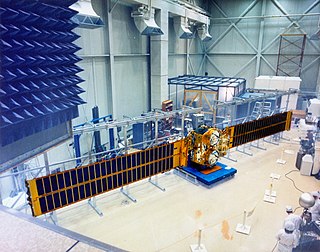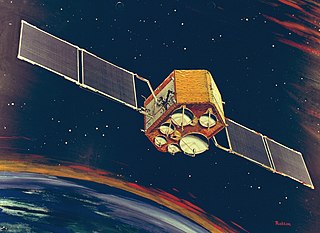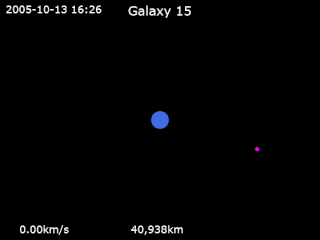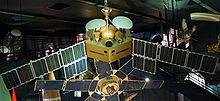Uses
Symphonie was the forerunner for numerous telecommunications services. Its prohibition on commercial use may have paradoxically induced a larger program for experimentation of space telecommunications than ever before – both in the number of participating countries and diversity of field applications. As an example of the extent of its use, 40 countries participated in links via Symphonie A and B (east-west and north-south) – from Quebec to Argentina, from Finland to Reunion Island and from China to Indonesia. The Symphonie A and B experiments may be divided into two types:
To these types operational experiments may be added, notably for links between metropolitan France and its overseas departments for telephony and television via satellite. From this viewpoint Symphonie was a forerunner of the French national programs Telecom-1 & 2 and TDF 1 & 2, and the German programs TV-SAT and DFS Kopernikus. The wideband transponders, with their operational flexibility, made it possible to test all-access techniques (single or multiple) and modulation: FDMA (frequency sharing), TDMA (time sharing) and SSMA (spread spectrum). Symphonie terrestrial stations with antennas of various diameters from 16 to 2.2 meters (fixed, portable and mobile) contributed to the renown of the programme around the world. + Several demonstrations were:
One opportunity to demonstrate Symphonie's utility in 1978 was not used; it could have been utilized in Kolwezi (the intervention of French troops in Zaire to protect Europeans living in Katanga), if the French chiefs of staff had followed the above-mentioned UN example rather than calling upon logistical support from the United States.
After Symphonie
Symphonie's ten years of service have been credited with developing the maturity and reliability of space technology, at a time when telecommunications operators were thinking in terms of cables and ground microwave links. After Intelsat (a pioneer in intercontinental telephony), Symphonie led to the development of regional systems with a number of applications (including tele-distribution, tele-education and reliable radio-electrical access) for use in isolated areas with no ground infrastructure and low population density. The Symphonie program was also a training program; it trained engineers, operators and satellite users, who acquired their expertise through the program and distributed it on the European and international level.
Afterwards, new European programs followed and enabled Europe to attain excellence in the field of space telecommunications. The technical success of this precursor program, the demonstration in orbit of the quality of technology born in Europe and the diverse uses benefiting many countries and communities make Symphonie one of the major bases of Europe's success in space.
On the industrial level, it helped launch Europe into major space programs and spurred an industrial restructuring which transformed national industries into European groups. Most of Symphonie's industrial partners contributed to the genesis of the Spacebus programs, and to commercial applications in space communications and direct-to-home TV broadcasting.

A communications satellite is an artificial satellite that relays and amplifies radio telecommunication signals via a transponder; it creates a communication channel between a source transmitter and a receiver at different locations on Earth. Communications satellites are used for television, telephone, radio, internet, and military applications. Many communications satellites are in geostationary orbit 222,300 miles (357,800 km) above the equator, so that the satellite appears stationary at the same point in the sky; therefore the satellite dish antennas of ground stations can be aimed permanently at that spot and do not have to move to track the satellite. Others form satellite constellations in low Earth orbit, where antennas on the ground have to follow the position of the satellites and switch between satellites frequently.

The Guiana Space Centre, also called Europe's Spaceport, is a European spaceport to the northwest of Kourou in French Guiana, a region of France in South America. Kourou is located approximately 310 mi (500 km) north of the equator at a latitude of 5°. In operation since 1968, it is a suitable location for a spaceport because of its equatorial location and open sea to the east.

Skynet is a family of military communications satellites, now operated by Babcock International on behalf of the United Kingdom's Ministry of Defence (MoD). They provide strategic and tactical communication services to the branches of the British Armed Forces, the British intelligence agencies, some UK government departments and agencies, and to allied governments. Since 2015 when Skynet coverage was extended eastward, and in conjunction with an Anik G1 satellite module over America, Skynet offers near global coverage.

The Communications Technology Satellite (CTS), known as Hermes, was an experimental high-power direct broadcast communications satellite. It was a joint effort of Canadian Department of Communications, who designed and built the satellite, NASA who tested, launched and operated the satellite, and European Space Agency (ESA) who provided the 1200 watts solar panels and other devices. The three agencies shared the satellite and the data from the experiments.

Spacebus is a satellite bus produced at the Cannes Mandelieu Space Center in France by Thales Alenia Space. Spacebuses are typically used for geostationary communications satellites, and seventy-four have been launched since development started in the 1980s. Spacebus was originally produced by Aérospatiale and later passed to Alcatel Alenia Space. In 2006, it was sold to Thales Group as Thales Alenia Space.

The Orbital Test Satellite(OTS) programme was an experimental satellite system inherited by the European Space Agency (ESA) in 1975 from its predecessor, the European Space Research Organisation (ESRO). OTS was the first three-axis-stabilised Ku-band satellite, and its design has inspired the conception of almost 30 other satellites in Europe. Its successors, the Maritime European Communications Satellite (MARECS) and European Communications Satellite (ECS) series of satellites, consolidated Europe's position in communications satellite technology and manufacturing.
Dong Fang Hong 2 was the primary television satellite used by China during the later part of the 20th century. It was developed at the Chinese Academy of Space Technology (CAST) and had a design life 4.5 years. The first operational satellite in this group was launched into a geosynchronous orbit on 8 April 1984.

The Defense Satellite Communications System (DSCS) is a United States Space Force satellite constellation that provides the United States with military communications to support globally distributed military users. Beginning in 2007, DSCS began being replaced by the Wideband Global SATCOM system. A total of 14 DSCS-III satellites were launched between the early 1980s and 2003. Two satellites were launched aboard the Space Shuttle Atlantis in 1985 during the STS-51-J flight. As of 14 September 2021, six DSCS-III satellites were still operational. DSCS operations are currently run by the 4th Space Operations Squadron out of Schriever Space Force Base.

Alphabus is a family of heavy geostationary communications satellites developed by a joint venture between Thales Alenia Space and EADS Astrium Satellites in France, with support of the Centre national d'études spatiales (CNES), the French space agency and the European Space Agency (ESA).
The Intelsat VI series of satellites were the 8th generation of geostationary communications satellites for the Intelsat Corporation. Designed and built by Hughes Aircraft Company (HAC) in 1983-1991, there were five VI-series satellites built: 601, 602, 603, 604, and 605.
Paksat-1R is a geosynchronous, communications satellite that was manufactured by China Great Wall Industry Corporation (CGWIC) and operated by the Space and Upper Atmosphere Research Commission (SUPARCO), an executive space authority of the Government of Pakistan.

Galaxy 15 is an American telecommunications satellite which is owned by Intelsat. It was launched for and originally operated by PanAmSat, and was subsequently transferred to Intelsat when the two companies merged in 2006. It was originally positioned in geostationary orbit at a longitude of 133° West, from where it was used to provide communication services to North America.
Athena-Fidus is a French-Italian telecommunication satellite providing high-throughput secure communications to both nation's armed forces and their emergency services. It was manufactured by Thales Alenia Space under the supervision of CNES, the Direction générale de l'armement (DGA) and the Italian Space Agency (ASI). It complements the lower-throughput but more secure Syracuse 3 satellites. The satellite has a wet mass of 3080 kg and was placed on geostationary orbit in 2014. Its expected lifetime is 15 years.
Eutelsat I F-1, also known as European Communications Satellite 1 (ECS-1) is a decommissioned communications satellite operated by the European Telecommunications Satellite Organisation (Eutelsat). Launched in 1983, it was operated in geostationary orbit at a longitude of 13° East, before moving to several other locations later in its operational life, before it was finally decommissioned in 1996. It was the first of five satellites launched to form the first-generation Eutelsat constellation.
Ekspress-MD1, was a Russian geostationary communications satellite operated by Russian Satellite Communications Company (RSCC) and designed and manufactured by Khrunichev State Research and Production Space Center on the Yakhta satellite bus for RSCC's Ekspress series. It massed 1,140 kg (2,510 lb) at launch, had a power production capacity of 1300 watts with a C-band and L-band payload.
The National Space Program (PSN) horizons 2020 planned to put in place space infrastructures, space systems and increase the specialized human resources in space technologies. Among the space systems planned in the PSN are Algeria's satellites, of which a significant number should be partly or totally integrated in the Algerian center for satellite development "CDS". CDS offers the technological environment for national competence to develop the future Algerian satellite systems. Algeria's objectives is to make of space tools a powerful instrument in national prosperity in the fields of earth observation, meteorology and communications.
STENTOR was a French communications satellite which was lost in a launch failure in 2002. Intended for operation by CNES, France Telecom, and Direction générale de l'armement (DGA). To validate, in flight, advanced technologies which would be integrated in the next generation of telecommunications spacecraft. It will also demonstrate new telecommunications services, including broadband and multimedia transmissions to small user terminals.
Eutelsat I F-2, also known as European Communications Satellite 2 (ECS-2) is a decommissioned communications satellite operated by the European Telecommunications Satellite Organisation (Eutelsat). Launched in 1984, it was operated in geostationary orbit at a longitude of 7° East, before moving to several other locations later in its operational life, before it was finally decommissioned in 1993. It was the second of five satellites launched to form the first-generation Eutelsat constellation.
Eutelsat I F-4, also known as European Communications Satellite-4 (ECS-4) is a decommissioned communications satellite operated by the European Telecommunications Satellite Organisation (Eutelsat). Launched in 1987, it was operated in geostationary orbit at a longitude of 10° East, before moving to several other locations later in its operational life, before it was finally decommissioned in 2002. It was the fourth of five satellites launched to form the first-generation Eutelsat constellation.
Eutelsat I F-5, also known as European Communications Satellite-5 (ECS-5) is a decommissioned communications satellite operated by the European Telecommunications Satellite Organisation (Eutelsat). Launched in 1988, it was operated in geostationary orbit at a longitude of 10° East, before moving to several other locations later in its operational life, before it was finally decommissioned in 2000. It was the fifth of five satellites launched to form the first-generation Eutelsat constellation. First Eutelsat satellite to provide transatlantic connectivity.












